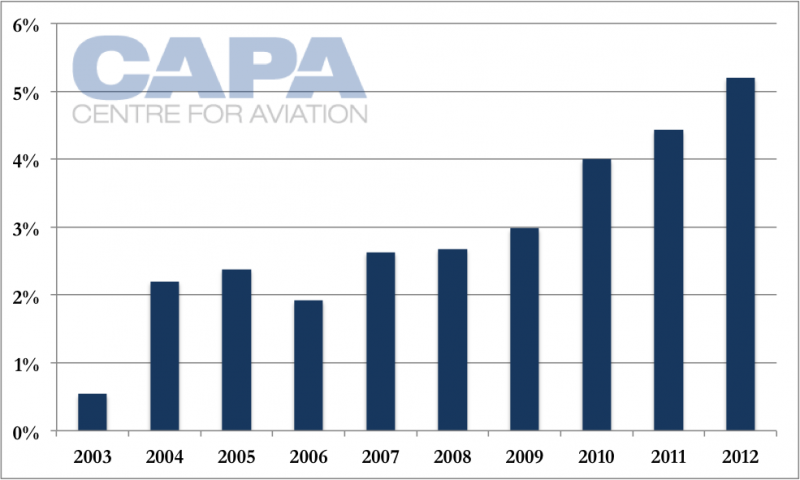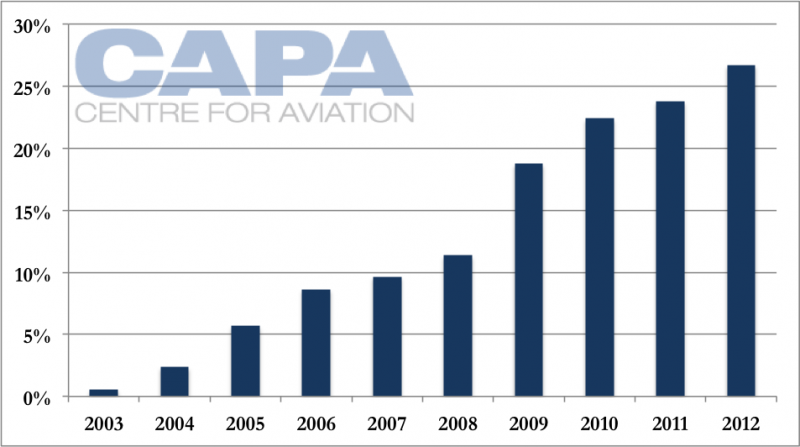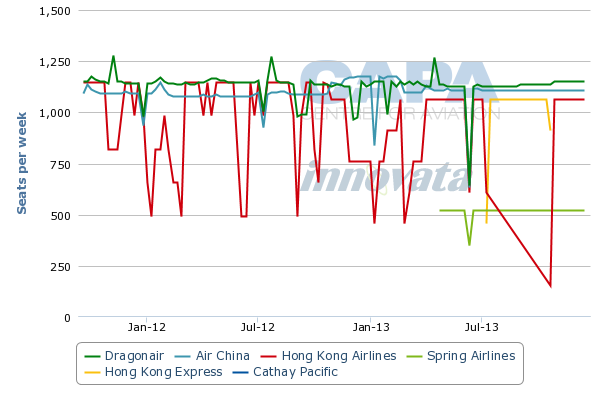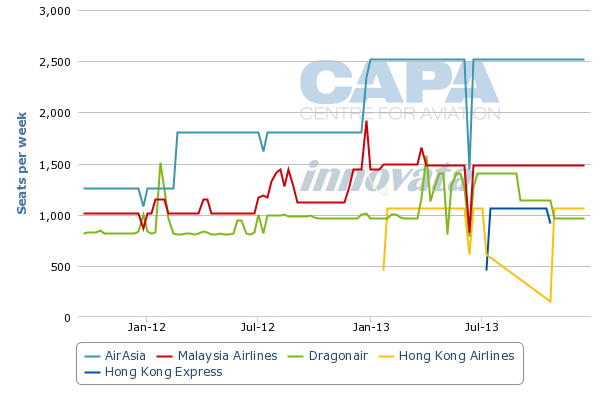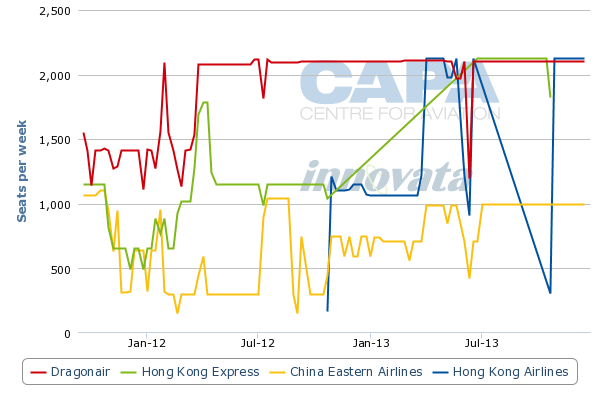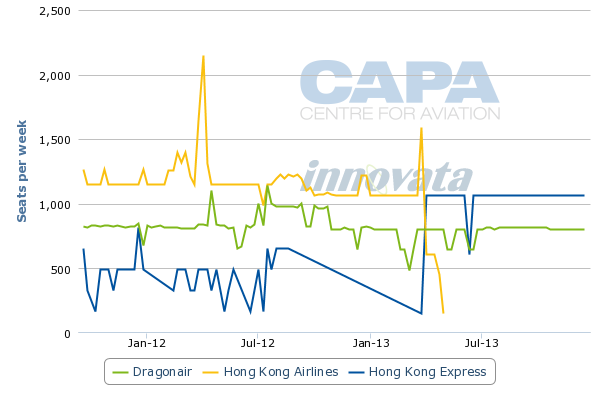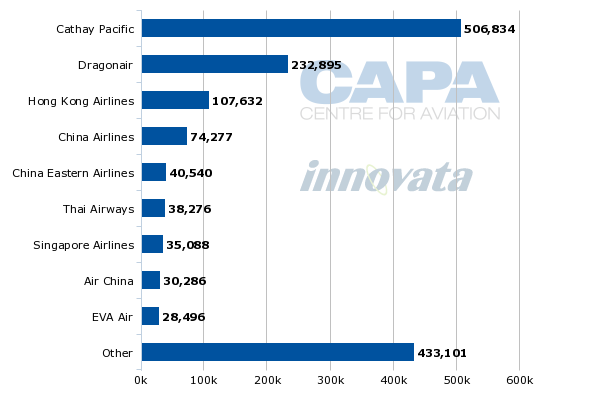Hong Kong Airlines embarks on dual-brand strategy with Hong Kong Express to become LCC
Hong Kong Airlines is the latest carrier in Asia to embrace a dual-brand strategy of complementing the full-service airline with an LCC subsidiary. HK Airlines will transform sister carrier Hong Kong Express, currently almost identical to HK Airlines, into an LCC launching services in the northern winter 2013/2014 schedule - around Oct-2013, giving Hong Kong its first low-cost carrier. HK Express plans to grow to 30 all-economy A320s by 2018, which should make it larger than planned LCC Jetstar Hong Kong.
Partially owned by China's HNA Group, HK Express plans to be a hybrid LCC, offering connections within its operation and that of HK Airlines and other HNA Group carriers, plus perhaps even other airlines. A premium offering may be added in a latter stage of growth. While HK Express may be able to transform into an LCC, its success will depend on the freedom HK Airlines offers it.
The success of the overall dual-brand strategy will depend on HK Airlines effectively marketing itself as a premium full-service airline, which it has yet to achieve. With HK Express taking the lion's share of the short-haul market, HK Airlines will resume its planned long-haul aspirations. There is a path for this strategy to pan out, but it will likely take time with many revisions.
Hong Kong Express to be Hong Kong's first LCC, beating Jetstar Hong Kong
Unless there are exceptional circumstances, Hong Kong Express will be Hong Kong's first LCC, beating to the title proposed start-up Jetstar Hong Kong. The launch of Hong Kong Express will help lift Hong Kong's LCC penetration rate, which was just over 5% in 2012 compared to over 25% in Singapore.
Hong Kong LCC penetration rate of available seat capacity: 2003-2012
Singapore LCC penetration rate of available seat capacity: 2003-2012
Hong Kong Express re-launching with five A320s in 2013
Hong Kong Express is currently an active airline (code: UO; Hong Kong Airlines: HX) on its own AOC but HK Airlines and HK Express are nearly interchangeable, with few branding and service differences. They share a common web booking system and management. Going forward management intends for the two to be freestanding and individually profitable, i.e. one will not cross-subsidise the other. Management projects Hong Kong Express to be profitable in two years.
The re-launch or transformation entails keeping HK Express flying to maintain the AOC while pairing back many aspects of the operation to the bare bones and then build up a low-cost operation. HK Express' A320s will be configured to an all-economy configuration while on the back office side HK Express will have its own systems so it can have a low-cost platform. Staff will be segmented when necessary so HK Express can foster a low-cost culture. But HK Express and HK Airlines will share resources and look to gain synergies in areas that will not hugely affect the low-cost side, such as payroll. So HK Express is not a traditional LCC start-up.
History has not been kind to full-service airlines that have tried to become LCCs, but the situation with HK Express is different as almost all of its infrastructure is not its own but rather with HK Airlines. So HK Express will effectively cut itself off from many parts of HK Airlines and then have an almost start-up environment. This makes it easier to transform the carrier into an LCC than how other carriers have tried - and failed - in the past.
Hong Kong Express has a "first flight" launch date it is keeping to itself but expects to launch in northern winter 2013/2014. The transformation will not happen on one day, but rather LCC Hong Kong Express flights will take over the current full-service Hong Kong Express flights over a few weeks.
HK Express' initial destinations will be mainly in mainland China. With the exception of Chongqing, they are primarily leisure points and will be catering to the outbound Hong Kong market with noticeably less inbound traffic. They are as follows:
Chongqing, China
The sprawling municipality in western China is, with Chengdu, the heart of China's "Go West" campaign as it looks to grow the economy in the western part of the country, away from the east coast, which has been China's traditional source of growth but is now slowing.
Although Chongqing is the start for cruises down the Yangtze River, it is short on leisure activities that would make it a typical LCC route. This in fact will be one of HK Express' more atypical routes. The service is likely grounded in wanting to target cost-sensitive business travellers as well as having to respond to mainland China's only LCC, Spring Airlines, which has entered the Hong Kong-Chongqing market, offering substantially lower fares.
Dragonair is the current market leader with Air China (a strategic partner of Dragonair's owner Cathay) and Hong Kong Airlines rivalling Dragonair depending on the week. In Jul-2013 Hong Kong Express will take over the route from Hong Kong Airlines. Spring typically has half the capacity of others. (It has served the route for a number of months but capacity only recently was included once Innovata started recording Spring's capacity as scheduled; previously it was chartered.)
Hong Kong International Airport to Chongqing Airport (seats per week, one way): 19-Sep-2011 to 22-Dec-2013
Guilin, China
A more traditional LCC destination, Guilin is one of China's most popular tourist destinations owning to its scenery, a pleasant retreat from city life. But the market from Hong Kong has not been properly developed. Only full-service carriers serve the route; an LCC could stimulate greater traffic with lower fares.
Dragonair and Hong Kong Airlines are the market leaders. As with Chongqing, Hong Kong Express will take over from Hong Kong Airlines in Jul-2013.
Hong Kong International Airport to Guilin Airport (seats per week, one way): 19-Sep-2011 to 22-Dec-2013
Kota Kinabalu, Malaysia
This market, reaching the centre of Malaysia Borneo (Sabah), a major tourist attraction, is dominated by AirAsia. A Hong Kong-based LCC will be able to provider greater competition. Hong Kong Airlines resumed serving the city in Jan-2013. As with Chongqing and Guilin, this route in Jul-2013 will be transferred from Hong Kong Airlines to Hong Kong Express.
Hong Kong International Airport to Kota Kinabalu Airport (seats per week, one way): 19-Sep-2011 to 22-Dec-2013
Kunming, China
Another typical LCC market, Kunming is the capital of Yunnan province, a major tourist attraction also for its nature and scenery. Dragonair and Hong Kong Airlines/Express trade off as market leaders, with China Eastern having a smaller presence, despite Kunming being one of China Eastern's main hubs.
Hong Kong International Airport to Kunming Airport (seats per week, one way): 19-Sep-2011 to 22-Dec-2013
Taichung, Taiwan
Taiwan's third-largest city is a smaller market and more suitable to an LCC, especially with the Taiwan-Hong Kong market having over-saturation of capacity in recent times as cross-Strait flights between mainland China and Taiwan expand. Passengers on those routes used to travel to China via Hong Kong but there has been no significant capacity decrease between Taiwan and Hong Kong to correspond to the fewer high-yielding passengers. An LCC positioning will be more competitive as it can compete on cost, whereas current carriers are decreasing fares without being able to cut costs.
The market leader is Mandarin Airlines, the subsidiary of Taiwan's China Airlines.
Hong Kong International Airport to Taichung Ching Chuan Kang Airport (seats per week, one way): 19-Sep-2011 to 22-Dec-2013
Sanya, China
Sanya is the centre of tourism on Hainan island, which enjoys warm weather year round and is a leisure tropical destination, considered by some to be China's Hawaii. This makes the destination conducive to LCCs, especially foreign ones as Sanya has yet to cultivate destination status outside of China. A hindrance to the route will be cost: Sanya caters to the largely wealthy population groups of China and prices are more expensive than what is acceptable in Southeast Asia.
Hong Kong Airlines/Express is the market leader to Sanya, with only Dragonair also serving the route. Sanya has been the fourth most frequent destination offered under Cathay/Dragonair's "Fanfares" programme, indicating the destination needs some price stimulation - which Hong Kong Express should be able to do with its lower costs and fares.
See related report: Cathay Pacific promotes cheap 'Fanfares' as quasi answer to LCCs, but structural change is needed
Hong Kong International Airport to Sanya Airport (seats per week, one way): 19-Sep-2011 to 22-Dec-2013
Hong Kong Express targets 30 A320s by 2018
HK Express is targeting a fleet of 30 A320s by 2018. This should make it larger than the planned Jetstar Hong Kong operation, which has targeted 18 A320s by 2015. Although it is theoretically possible that Jetstar Hong Kong could add 12 or more aircraft in three subsequent years, it is difficult to envision this.
First, Jetstar Hong Kong's 18 by 2015 target was assuming an early/mid-2013 launch. Even a late 2013 launch will be challenging - assuming necessary approvals come through after bringing a local shareholder onboard. With a delayed launch, some aircraft deliveries will need to be pushed back as otherwise the operation will be under stress if it grows too rapidly. There would also be financial stress as such growth results in initial over-capacity and large losses.
See related reports:
- Jetstar Hong Kong's local investor reflects HK's new attitude, learning from Hong Kong Airlines
- Jetstar Hong Kong is group's largest launch challenge yet but with a tremendous potential upside
Second, Jetstar Hong Kong wanted large initial growth to secure slots at Hong Kong, which are rapidly decreasing. While start-ups often have higher initial growth than later years, Jetstar Hong Kong was going to skew the curve even more, with growth concentrated in earlier stages. It is unlikely Jetstar Hong Kong would have had a growth profile similar to what Hong Kong Express has now, but Jetstar Hong Kong may very well look to higher growth in latter years than what it initially planned, its application pending.
See related report: Hong Kong's low-cost airline presence could triple to 15% of seats in 2015
The two no doubt will be fierce competitors, not just for operational reasons but also historical: Jetstar had wanted to buy Hong Kong Express and transform it into an LCC before rejection saw it move to its partnership with China Eastern.
Hong Kong Express' planned 30 aircraft will make it a smaller rival to Dragonair, which in Jun-2013 had 38 aircraft, 17 of which were widebodies. While Dragonair is expected to grow, it will be modest and smaller than Jetstar Hong Kong or Hong Kong Express.
Dragonair Fleet Summary: as at 30-Jun-2013
| Aircraft | In Service | In Storage | On Order |
|---|---|---|---|
| Total: | 38 | 0 | 0 |
| Airbus A320-200 | 15 | 0 | 0 |
| Airbus A321-200 | 6 | 0 | 0 |
| Airbus A330-300 | 8 | 0 | 0 |
| Airbus A330-300X | 9 | 0 | 0 |
New destinations to be served from Nov-2013
Hong Kong Express' initial route network will be existing destinations in the Hong Kong Airlines group. But from Nov-2013 HK Express plans to add entirely new destinations to the group, targeting leisure points from Hong Kong. Some route transfers from Hong Kong Airlines are likely. Hong Kong Airlines and Hong Kong Express' route approvals are interchangeable. It is likely that in the medium-term Hong Kong Express will operate alongside Hong Kong Airlines to Shanghai and Taipei.
Hong Kong Express sees itself aiming for destinations in northern Asia, like Japan and South Korea but also Mongolia and as far north in China as Harbin. To the south Hong Kong Express sees Indonesia as its southern limit while to the west HK Express could go as far as Nepal.
Hong Kong's geography - about in the middle of key Asian markets - is advantageous in that it facilitates high utilisation rates, which reduces fixed costs. Peach has an overnight flight from Hong Kong to Osaka Kansai while Tiger Mandala in Jul-2013 will start a Jakarta-Hong Kong service that leaves Hong Kong at 02:30 in the morning and arrives in Jakarta at 06:30 in the morning. For both of these airlines, their aircraft would otherwise be sitting on the ground. Such back of the clock opportunities are more limited to airlines in Southeast Asia and far northern North Asia. Hong Kong Express is expected to have a number of back of the clock flights, a reflection of utilisation drives but also when slots at Hong Kong airport are available.
Hong Kong Express is targeting utilisation rates close to 13 hours, a marked improvement over Dragonair's 2012 utilisation rates of just under nine hours for A320s/A321s. Turnaround times are targeted to be reduced from 40 minutes to 30 minutes.
Management expects Hong Kong Express to offer lead-in fares 30% lower than what is currently on the market. (There will also be limited sales with exceptionally low fares.) Yields in North Asia are high, either a sign of large profits (which in recent years have been trying) or cost bases too high. It is often cheaper to fly from Singapore to Taipei or Tokyo than from Hong Kong to Taipei or Tokyo.
Hong Kong Airlines will retain short-haul routes and narrowbody aircraft
Hong Kong Airlines will, for now, maintain short-haul full-service routes and narrowbody aircraft. Short-haul narrowbody routes include destinations like Chengdu and Hanoi. Widebody A330s are used on popular leisure routes like Denpasar (Bali) and Bangkok, plus routes where a premium offering is needed for business purposes, such as Beijing and Shanghai.
Hong Kong Airlines Fleet Summary: as at 30-Jun-2013
| Aircraft | In Service | In Storage | On Order |
|---|---|---|---|
| Total: | 23 | 0 | 50 |
| Airbus A320-200 | 8 | 0 | 16 |
| Airbus A330-200 | 7 | 0 | 0 |
| Airbus A330-200F | 4 | 0 | 0 |
| Airbus A330-300 | 3 | 0 | 3 |
| Airbus A330-300E | 1 | 0 | 0 |
| Airbus A350-900XWB | 0 | 0 | 15 |
| Airbus A380-800 | 0 | 0 | 10 |
| Boeing 777F | 0 | 0 | 6 |
Hong Kong Airlines Asia destinations: 30-Jun-2013
- Bangkok Suvarnabhumi International, Beijing Capital International Airport, Chengdu Airport, Chongqing Airport, Denpasar Bali Ngurah Rai Airport, Fuzhou Airport, Guiyang Airport, Haikou Airport, Hailar Airport, Hangzhou Airport, Hanoi Noibai Airport, Harbin Airport, Hohhot Airport, Kota Kinabalu Airport, Nanjing Lukou International Airport, Okinawa Naha Airport, Phuket International Airport, Shanghai Hongqiao Airport, Shanghai Pudong Airport, Taipei Taoyuan International Airport, Taiyuan Airport, Xiamen Airport
Hong Kong Airlines is the third largest airline in Hong Kong, behind Cathay and Dragonair.
Hong Kong International Airport (seat capacity by week): 1-Jul-2013 to 7-Jul-2013
Hong Kong International Airport (seat capacity share by week): 1-Jul-2013 to 7-Jul-2013
HK Express targeting point-to-point, but transfer traffic - and partners - will be critical
Hong Kong Express wants to target point-to-point traffic from Hong Kong, which includes not only relatively small Hong Kong (population: seven million) but the larger Pearl River Delta area that can access Hong Kong via ferries and ground transport. The greater catchment area has about 100 million people. Hong Kong Airport has an integrated network of ferries and coaches, and Hong Kong Express will seek to tap into this network for greater feed.
But at the end of the day Hong Kong is still a huge transfer market. Based on airline, airport and tourism statistics, about half of air passengers at Hong Kong make an immediate connection. Half of the remaining passengers make an indirect connection via a ferry or ground transport. That leaves Hong Kong with only a quarter of local passengers.
Hong Kong Airlines/Express' current network sees large volumes of transfer traffic, mainly from mainland China onwards to Southeast Asia, even if some connections are not efficient in terms of distance. But this is a reflection of Chinese carriers focusing on the more profitable domestic market. Internationally they lack the marketing strength, cost advantage as well as having high frequencies.
Hong Kong Express plans to offer connections (and Hong Kong stopovers) within its operation as well as to and from Hong Kong Airlines and fellow sister airlines that are also a part of the HNA Group. HNA is currently transforming West Air, based in Chongqing (future Hong Kong Express destination) into an LCC. Hong Kong Express is also interested in working with other airlines for feed. Not only could Hong Kong Express offer additional transfer options, but it could do so at a lower cost and bring competition to interline agreements with Cathay Pacific and Dragonair, which have had a firm grasp on the market.
While transfer traffic will be necessary, Hong Kong Express management says it will not favour it over utilisation efficiency. This may change over time as Hong Kong Express gains scale. Singapore presents a worthy comparison, and in 2011 (the latest figure available) Singapore-based Jetstar Asia had at least 15% of its passengers connect on another air service. Jetstar Asia is increasingly mindful of the potential of transfers when looking at its schedule.
A reckoning may be needed for Hong Kong Airlines to transfer more routes to HK Express
While the Hong Kong Airlines Group is wise to cut costs and make regional Asian traffic more affordable, it is creating an overly-complex arrangement that will likely lead to frustration at both airlines as well as result in confusion in the market.
With connections critical in the Hong Kong market, the airlines will find themselves with a number of city-pairs where one segment is operated by low-cost Hong Kong Express and the other segment by full-service Hong Kong Airlines. The Jetstar Group for one has demonstrated how to accommodate full-service carriers transferring passengers onto its low-cost flights, but this may be more than what Hong Kong Airlines/Express can handle as they embark on a major strategy change; Jetstar facilitated connections gradually. Scoot, just over a year old, has transfers with full-service sister airlines (and owners) Singapore Airlines and SilkAir, but these are one way: Scoot places passengers onto SIA/SilkAir while SIA/SilkAir do not place passengers onto Scoot. This means there is no risk of a full-service passenger finding himself on an LCC instead and being upset at the difference in service quality.
There will also be a loss in scale. Hong Kong Express intends to serve Shanghai in due course, which will bring a low-cost option to the Hong Kong Airlines portfolio and see the carrier compete against Spring, which has three daily Hong Kong-Shanghai flights. But slots at Shanghai are all but gone, save for undesirable midnight hour slots. This could see Hong Kong Airlines maintain its current schedule while Hong Kong Express has flights at undesirable times (a disadvantage to Spring). Or Hong Kong Express could take a frequency from Hong Kong Airlines, but this loosens the full-service proposition. Hong Kong Airlines is already a smaller competitor, with three or four daily flights, compared to Cathay/Dragonair, with a dozen-odd Hong Kong-Shanghai flights.
A dual-brand strategy is challenging here as there are not considerable growth opportunities in markets like Shanghai and Beijing. (Cathay/Dragonair could more adequately have a FSC and LCC dual-brand strategy as they already have numerous slots.) The gold standard for dual-brand strategies is typically attributed to the Qantas-Jetstar model. There Jetstar and Qantas operate on key trunk routes like Melbourne-Sydney (the world's fourth busiest route) but this was made possible by there being no growth constraints, or at least no where on the order of magnitude as in Shanghai and Beijing, and other slot-restricted cities. In fact, the less constrained nature of Australia means Jetstar is able to easily offer connections across the country on its own services. Hong Kong Express will not be able to build up as large and diverse a network, so connections with others will be important.
The easy option from an operational view is for the Hong Kong Airlines Group to make the entire Hong Kong Airlines/Express short-haul network low-cost but highly hybridised so as to accommodate business or long-haul passengers, such as by having fare bundles and even a premium seat option, like blocking the middle seat. This is the concept from the highly successful Vueling based in Barcelona. Other European legacy airlines (with long-haul networks) have had a near low-cost platform. In recent years they have turned to dedicated LCC spin-offs, like Iberia's Iberia Express, Lufthansa's Germanwings, AF-KLM's Transavia. But this has been driven as much by operational concerns as the need to free the full-service airlines from strong unions defending legacy models. Without such concerns, there would be greater scope to make the short-haul legacy operations more low cost. Full-service carriers in the United States meanwhile effectively became low-cost by entering bankruptcy protection, which allowed them to re-negotiate staff contracts. With the cost gap narrowed that way, a dedicated LCC spin-off became less pragmatic.
But making all of Hong Kong Airlines/Express short-haul an LCC operation may be too radical a thought now. In legacy airlines there are always mindsets that value the pride of being full-service over profits. The A330s do present an operational challenge, but not an insurmountable one. They could be used in a full-service configuration in between future long-haul flights - "intentional misuse" - or there could be merits to have a dedicated LCC widebody sub-fleet. Scoot is demonstrating the use of widebody 777-200 flights (with two types of seats) on short-haul routes (Singapore-Bangkok/Taipei, Taipei-Tokyo/Seoul) while Cebu Pacific will use its all-economy A330s on short-haul trunk routes (Manila to Singapore and points in China) in addition to long-haul flights, initially to the Middle East.
There may be a premium market, of whatever size, in Asia in the long-term, but there will be a far larger budget market.
Difference in cost base between HK Airlines and HK Express may not be huge
There are questions of how successful this dual-brand strategy will be since Hong Kong Airlines already had a low cost base. (Financial figures are not disclosed.) Hong Kong Airlines has kept a low headcount at its Hong Kong office, employing staff where possible over the border in Shenzhen, where salaries are substantially lower than in Hong Kong. Hong Kong Airlines was also beginning to ramp up aggressive utilisation rates, as seen by a Hong Kong-Bangkok-Hong Kong rotation that operated in midnight hours when the aircraft would otherwise be sitting on the ground. Hong Kong Airlines has told staff that there will be no reductions in wages or benefits for Hong Kong Express staff, reducing the opportunity for improvements (wages or productivity) there.
What was not fundamentally low-cost about Hong Kong Airlines was the two-class and low-density configuration, high expenditure on product (which Dragonair has subsequently matched) and not charging for luggage and smaller items like food and beverage, which Hong Kong Express will charge. There is also back office inefficiencies, including a website that had not been ramped up. Hong Kong Express may be able to become an LCC, but Hong Kong Airlines may have been able to do that as well, although perhaps not so quickly. And Hong Kong Airlines' A330s, if used correctly, could deliver a cost advantage over Hong Kong Express' A320s, as seen by A330 operator AirAsia X having a lower operating cost than A320 operator AirAsia Berhad (both based in Malaysia).
Then the question is if the cost - let alone complexity to staff and the market - of maintaining two brands is offset by revenue. In the Qantas-Jetstar dual-brand strategy, Qantas is a legacy airline with a substantially higher cost base than Jetstar. Hong Kong Airlines, however, does not come with all of that legacy baggage.
Booking system powered by TravelSky - targeting 80-90% direct sales
Hong Kong Express has selected TravelSky, China's GDS, as its booking platform. With foreign GDS not yet fully welcome in China, using TravelSky will enable Hong Kong Express to maximise its visibility. Hong Kong Express will also make fares available via travel agents, who have a significant role in the Hong Kong and mainland Chinese market. Fares will be on the GDS (TravelSky has lower costs than foreign GDS) but Hong Kong Express is targeting, perhaps optimistically, 80-90% of fares to be sold on direct channels within two years. It expects mobile bookings to be especially popular given the smartphone penetration rate in Hong Kong, one of the world's highest, and will target this channel.
HK Express hopes regulator will permit 180 seat A320s instead of current 174 seat limit
Hong Kong Express is reconfiguring two-class A320s from 152 seats (eight in business and 144 in economy) to 174 all-economy seats, a 14% increase in seats and also a wider number of seats to spread fixed costs across.
The A320 is certified to carry a maximum of 180 passengers, and 180 seats is the typical configuration for LCCs. But a Hong Kong regulation does not permit 180 seats in an A320 (174 is the maximum).
Hong Kong Express hopes to work with the regulator to change this and increase seats to 180, which would represent an 18% increase over the existing 152 seat configuration.
HK Express sees itself forcing change with suppliers
Hong Kong Express concedes the supplier outlook in Hong Kong and foreign ports is difficult, with suppliers locked in a mindset of a single service - and price - level. The carrier expects this to gradually change, as has occurred in Japan and Malaysia, with AirAsia for one bringing incredible change to the supplier and service provider environment. Other carriers should benefit from ground Hong Kong Express gains.
'Hong Kong Express' name not set in stone; could cause confusion with Hong Kong Airlines
Key to a dual-brand strategy is differentiation between the two brands. Hong Kong Express may conflict with Hong Kong Airlines because of the similarity in names, which would mean a passenger expecting full-service Hong Kong Airlines ends up on low-cost Hong Kong Express. As it stands, Hong Kong Airlines has a low brand visibility, with some mistakenly calling it Air Hong Kong (which in fact is a freighter airline) or Hong Kong Air.
Management is not infatuated with the name. In the short-term the name works and allows for a quick launch rather than undertaking an arduous branding process. Also important is the mention of Hong Kong in the name, and the connotation that it is a Hong Kong carrier, a swipe at Jetstar Hong Kong likely to be managed at the top level out of Melbourne, or Shanghai, but not Hong Kong. (Although this is perhaps a contraction as Hong Kong Airlines listens heavily to mainland China's HNA.) The word "Express" has historically denoted a lower cost operation (People Express, Delta Express, and now Iberia Express), but this is true primarily in the western world and is unlikely to weigh the same as in Asia.
Management is open to seeing how the brand gains traction and, if necessary, re-branding Hong Kong Express.
LCC transformation being led by Mango Aviation Partners - but what happens once they finish?
There is a shortage of aviation talent in greater China (Air China for one is sponsoring MBAs). So for Hong Kong Express' translation to an LCC, the carrier brought in Mango Aviation Partners, which have launched a number of LCCs, including Peach Aviation in Japan. No doubt they will be able to establish a low-cost base for Hong Kong Express.
The carrier's future is pegged not just on how it integrates with Hong Kong Airlines but also how the carrier continues with its low-cost base once the Mango staff leave. (And with Hong Kong Airlines keeping a watch on expenses, it is mindful of the cost impact of expatriates.) While Mango is committed to creating a low-cost culture that can regenerate itself, the end outcome is beyond Mango's control.
Hong Kong Airlines must now market itself as a premium full-service airline
Hong Kong Express has work to do, but so too does Hong Kong Airlines, which in recent times has been Asia's fastest-growing medium-sized airline. With Hong Kong Express strongly targeting the budget sector, Hong Kong Airlines must be strong in the premium space. It has arguably made the hard product investment but done little to market it, which some see representational of Chinese companies, and airlines especially, having weak marketing, either due to poor market targets or not investing enough in marketing.
See related reports:
- Hong Kong Airlines continues expansion; Jetstar HK appoints CEO & Dragonair to grow closer to Cathay
- Hong Kong Airlines, Asia's fastest growing carrier, looks to become reckoning force in the region
Without moving the Hong Kong Airlines brand upscale, it will fail to gain the appropriate yield premium and will be over-shadowed by its lower-cost sister, Hong Kong Express. (This assumes Hong Kong Airlines wants to continue with having a presence in short-haul markets rather than hand them all over to Hong Kong Express.)
Hong Kong Airlines applies for long-haul routes: Delhi, Istanbul, Almaty and London
With Hong Kong Express fuelling short-haul growth in the Hong Kong Airlines/Express group, Hong Kong Airlines is expected to resume its focus on medium/long-haul markets. The carrier has dabbled in long-haul markets, most infamously with an ill-advised all-business-class service from Hong Kong to London, which lasted for about six months.
But there is justification for medium/long-haul routes in a more proper dual-class configuration, and on routes that are operated with strategic partners or go into a hub of a partner, facilitating onward transfers.
Hong Kong Airlines in May-2013 applied with regulators to serve Delhi, Istanbul, Almaty and London, amongst numerous short-haul destinations. But details are few, as the routes could be formalities, and the application says the destinations may be served with passenger or freighter A330s.
The cards are on the table. Next move goes to Cathay Pacific. But will it awake from its slumber?
Jetstar Hong Kong's broad strategy (application pending) is known, and now so too is the complex, perhaps exceedingly so, strategy of Hong Kong Airlines/Express. There are not many more pieces of the puzzle to emerge. So whatever Cathay Pacific is planning - and it is difficult to suggest the carrier has absolutely no plans - as a response to the low-cost growth segment, its card is the next to be played.
While Hong Kong Airlines, and to a lesser extent, Jetstar Hong Kong figure out how to put the puzzle pieces together, there is an opportunity for Cathay to come in and blow the competition out of the water. It should be capable of managing a dual-brand strategy and has the resources and brand power to gain scale competitors dream of.
See related report: Cathay Pacific must seize the moment and launch a low-cost carrier
The alternative scenario is one of stagnation and long-term pain from ignoring the low-cost segment, which not only will see passengers switch from low-cost to full-service airlines, but also create an entirely new growth market.
Outlook: It was time for a new strategy. But this one will evolve
Hong Kong Airlines had found itself with aircraft and routes but lacking a strong identity, let alone following. It was trying to be full-service without premium yields while not having a low enough cost base to sustainably attract the low-cost segment. It saw Jetstar and Spring coming to Hong Kong, and knew a strategic restructuring was in order.
It is encouraging to see the carrier enter the low-cost market with Hong Kong Express. This is undoubtedly where growth is. But Hong Kong Express' future will depend heavily on Hong Kong Airlines. Dual-brand strategies are still avant-garde and complex, let alone for carriers less than 10 years old. There are more failures than successes.
While Hong Kong Airlines/Express' strategy is unlikely to fail, it will likely need to be constantly monitored and is likely progressively to be heavily revised. A premium product and name are possibilities. But more fundamental is the need to perhaps bring short-haul flights under one banner given slot restraints that limit frequency and scale - plus questions of Hong Kong Airlines achieving yield premiums from its full-service product.
This new strategy is a bold move. Inevitable future changes to the strategy should not be seen as a weakness but rather evolving the concepts of dual-brand strategies and LCC hybridity, which so many struggle with. These are evolving markets with potentially high growth. Innovation and adaptation are the name of the game.
